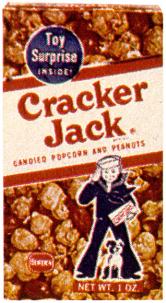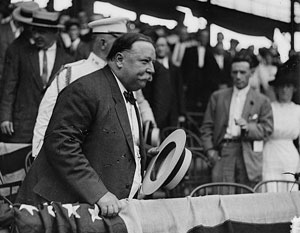Cracker Jack
Cracker Jack® is a staple of American cuisine and satisfies three of the Four Food Groups in American nutritional nagging. (Washed down with a can of beer, all four of the Food Groups are covered.) Cracker Jack consists of sugar-coated popcorn. It is pleasingly sticky to the fingers, and pleasingly annoying when used as a projectile at Minor League Baseball games.
Uses
Two common uses of Cracker Jack are alluded to above: eating it, and throwing it. Another use is finger-painting, on the nearest available wall, right after eating a box, without the need for finger paint.
A less common use is as a test to see whether someone is really an American. A swarthy foreigner trying to imitate an American, perhaps when prompted to sing Take Me Out to the Ballgame with its rousing stanza begging one's companion to "buy me some peanuts and Cracker Jack" will put the trademark into the plural, asking for "Cracker Jacks." One would hardly spend Thanksgiving dinner asking the hostess to pass the "corns," ugh. As in the movie Stalag 17, the impostor is immediately revealed. In fact, an authentic American cannot sing the baseball anthem in the first place without remarking on the redundancy, as there are already peanuts inside every box of Cracker Jack.
There is also a prize in every box of Cracker Jack, and a typical American feels justified in eating himself into morbid obesity by the need to collect Decoder Rings in all six colors, and maybe a couple miniature police whistles as well.
There is also a cheerful sailor boy on every box, accompanied by his dog, as most Navy personnel bring the family pet aboard during missions. The dog is named Bingo and the sailor went on to become Popeye. The sailor motif is a memento of those several times when America was savagely attacked by a foreign nation without warning. (Without unambiguous warning, ignoring idle murderous rhetoric by their insane dictator, which could hardly be taken seriously by a President with momentous domestic reforms on his mind.) The Cracker Jack box harks back to a patriotic interlude in American history--during the bold, manly response to that attack, and before it had dragged into decades-long occupation of a foreign country where they dress funny, at ruinous expense to the national treasury. Clearly it is a bridge to a simpler time. Americans can think about that simpler time, without actually having to simplify anything. And while they are thinking, they can stuff their faces.
History
Frederick William "Fritz" Rueckheim was originally a food vendor and Community Activist in Chicago. Rueckheim was a health-food nut, and his original confection was bean sprouts lightly sprinkled with oregano. Its transformation into the current agent of obesity is a fascinating study in Market Research that is thankfully outside the scope of this article.
Rueckheim bought out his partner Brinkmeyer and brought his brother "Hans" over from Germany, founding Rueckheim & Bro. The first word could never be pronounced, but the last word is evidence of the European roots of modern Ebonics.
The Rueckheims manufactured their health treat in a cement mixer, and successfully concealed their dirty little secret, that oil had to be added (in this case, synthetic thirty-weight) to keep the Cracker Jack from congealing into a solid that could not be removed from the mixer, as it turned out customers were unwilling to go into it to consume the snack.
The brainstorm of manufacturing a product no one wanted to eat, in a form that no one could, took days to blow over. Substituting molasses for oregano and ditching the bean sprouts was the first step. The final step occurred in 1908, when the company got a name change to The Cracker Jack Corporation and planted "guerrilla marketeers" in ballparks around the United States to organize "spontaneous" songfests in the middle of the seventh inning in which strategically placed fans sang out for free Cracker Jack.
The crowd reaction was unanimous — "What's that?" — and most ballparks of that era lacked WiFi to google Cracker Jack. Fortunately, the Rueckheim brothers had snuck dozens of nephews into the United States through Family Reunification, and they were waiting at the exits to sell smart little boxes with the dumb little sailor. It took only a few more years to find a way to sell the treat on the way into the game.
Like all successful innovations, Cracker Jack resulted in the acme of success for Rueckheim and Bro: They sold the business to giant agri-business Borden (then to Frito-Lay), lived out their lives on a yacht in the Cayman Islands, and didn't worry about what was in the box or in what country the machines stamping them out were located, as customers didn't either. Frito-Lay would go on to adapt the popular brand to new uses, such as a new line of even saltier and sugarier treats and a dating website where interactions are limited to 140 seconds and are given a cute name.
Other Cracker Jacks
Cracker Jack (or crackerjack) has come into the parlance as a slang expression for excellence. A yachtsman may be a "crackerjack skipper" (which sounds better than a "bang-up sailor"), and a ballplayer may be a "crackerjack infielder." This may mean either that he is good or that fans throw a lot of Cracker Jack at him.
Grammatically, the conversion of a substance that does not take a plural into a term of endearment follows the use of the expression "dipshit."
See also
| Featured version: 22 March 2014 | |
| This article has been featured on the main page. — You can vote for or nominate your favourite articles at Uncyclopedia:VFH. | |



